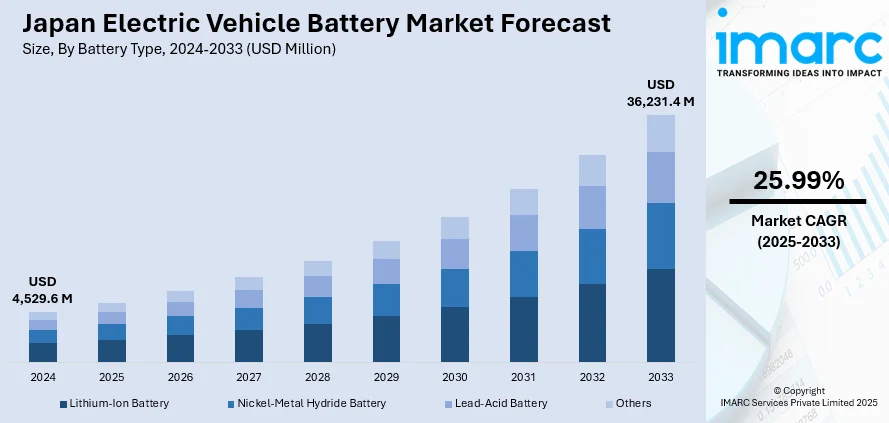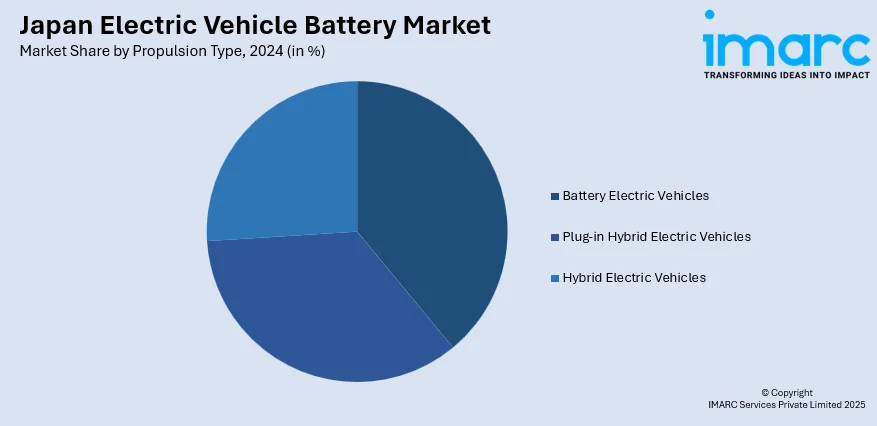
Japan Electric Vehicle Battery Market Size, Share, Trends and Forecast by Battery Type, Propulsion Type, Vehicle Type, and Region, 2025-2033
Japan Electric Vehicle Battery Market Overview:
The Japan electric vehicle battery market size reached USD 4,529.6 Million in 2024. Looking forward, IMARC Group expects the market to reach USD 36,231.4 Million by 2033, exhibiting a growth rate (CAGR) of 25.99% during 2025-2033. Increased government support, ongoing technological advancements, growing financial incentives, several developments in battery infrastructure, widespread R&D outlays, supportive government policies, and the development of better battery chemistry are some of the factors that are positively impacting the market.
|
Report Attribute
|
Key Statistics
|
|---|---|
|
Base Year
|
2024 |
|
Forecast Years
|
2025-2033
|
|
Historical Years
|
2019-2024
|
| Market Size in 2024 | USD 4,529.6 Million |
| Market Forecast in 2033 | USD 36,231.4 Million |
| Market Growth Rate 2025-2033 | 25.99% |
Japan Electric Vehicle Battery Market Trends:
Increased Government Initiatives and Policy Support
The Japanese government’s active role in promoting electric vehicles (EVs) plays a central role in the Japan electric vehicle battery market growth. With ambitious targets to reduce carbon emissions and accelerate the adoption of clean energy solutions, the government has introduced a series of policies aimed at encouraging the shift to electric mobility. These policies include financial incentives such as subsidies for EV purchases, tax reductions, and rebates for battery manufacturers. Additionally, Japan has been investing in the necessary infrastructure, such as expanding EV charging stations across urban and rural areas. These government-backed efforts are integral to ensuring the market’s long-term sustainability. The Japan electric vehicle battery market outlook also sees further advancement in these policy-driven initiatives, as the government is pushing for broader industry collaborations. On September 6, 2024, Nissan announced a new development strategy for next-generation EV batteries, focusing on solid-state battery production and scaling by fiscal year 2028. The company aims to cut charging time to one-third and reduce battery costs by 50%, reinforcing Japan’s position in advanced EV battery technology. This integrated approach, combining financial support with infrastructure development, has significantly impacted the overall EV ecosystem, ensuring a steady increase in EV adoption and demand for high-performance batteries. By supporting research and development, Japan is also positioning itself as a global leader in battery technology, which in turn is positively influencing the Japan electric vehicle battery market.

Advancements in Battery Technology and Cost Efficiency
Technological improvements in battery performance are a crucial factor driving the Japan electric vehicle battery market. As automakers and battery manufacturers invest in research and development, innovations in battery chemistry, energy density, and charging speed have contributed to more efficient and reliable EV batteries. This has directly led to the reduction in the overall cost of production, making electric vehicles more accessible to the mass market. Enhanced battery life cycles and faster recharging capabilities are also contributing to the increased adoption of EVs. Furthermore, Japanese manufacturers have been leading the way in the development of solid-state batteries, which are expected to offer even greater efficiency and safety compared to conventional lithium-ion batteries. For instance, on November 21, 2024, Honda unveiled a next-generation electric vehicle series, the “Honda 0 Series,” which will debut globally starting 2026 with a focus on software-defined architecture and advanced battery technology. The initiative underscores Honda’s long-term strategy to strengthen its position in the Japan EV battery market through lighter, more efficient battery systems and enhanced vehicle intelligence. As these developments unfold, the Japan electric vehicle battery market share continues to expand, with an increasing number of players entering the market to leverage these technological breakthroughs. The market growth is further supported by the competitive landscape, where local manufacturers are gaining a technological edge, further enhancing their standing in both domestic and international markets.
Japan Electric Vehicle Battery Market Segmentation:
IMARC Group provides an analysis of the key trends in each segment of the market, along with forecasts at the country level for 2025-2033. Our report has categorized the market based on battery type, propulsion type, and vehicle type.
Battery Type Insights:
- Lithium-Ion Battery
- Nickel-Metal Hydride Battery
- Lead-Acid Battery
- Others
The report has provided a detailed breakup and analysis of the market based on the battery type. This includes lithium-ion battery, nickel-metal hydride battery, lead-acid battery, and others.
Propulsion Type Insights:

- Battery Electric Vehicles
- Plug-in Hybrid Electric Vehicles
- Hybrid Electric Vehicles
The report has provided a detailed breakup and analysis of the market based on the propulsion type. This includes battery electric vehicles, plug-in hybrid electric vehicles, and hybrid electric vehicles.
Vehicle Type Insights:
- Passenger Car
- Commercial Vehicles
- Two-Wheeler
The report has provided a detailed breakup and analysis of the market based on the vehicle type. This includes passenger car, commercial vehicles, and two-wheeler.
Regional Insights:
- Kanto Region
- Kansai/Kinki Region
- Central/Chubu Region
- Kyushu-Okinawa Region
- Tohoku Region
- Chugoku Region
- Hokkaido Region
- Shikoku Region
The report has also provided a comprehensive analysis of all the major regional markets, which include Kanto Region, Kansai/Kinki Region, Central/Chubu Region, Kyushu-Okinawa Region, Tohoku Region, Chugoku Region, Hokkaido Region, and Shikoku Region.
Competitive Landscape:
The market research report has also provided a comprehensive analysis of the competitive landscape. Competitive analysis such as market structure, key player positioning, top winning strategies, competitive dashboard, and company evaluation quadrant has been covered in the report. Also, detailed profiles of all major companies have been provided.
Japan Electric Vehicle Battery Market News:
- On March 19, 2025, Ample entered into a partnership with several Japanese OEMs to roll out EV battery swapping stations across Tokyo, introducing a faster, scalable alternative to conventional charging. This marks a key advancement in Japan’s EV battery market, addressing urban charging constraints and supporting broader fleet electrification.
- On March 6, 2025, Nuvve established NUVVE Japan to bring its vehicle-to-grid (V2G) platform into the Japanese market. By enabling two-way energy flow between EV batteries and the power grid, the initiative strengthens Japan’s EV battery market through improved grid integration and support for energy-efficient mobility systems.
Japan Electric Vehicle Battery Market Report Coverage:
| Report Features | Details |
|---|---|
| Base Year of the Analysis | 2024 |
| Historical Period | 2019-2024 |
| Forecast Period | 2025-2033 |
| Units | Million USD |
| Scope of the Report |
Exploration of Historical Trends and Market Outlook, Industry Catalysts and Challenges, Segment-Wise Historical and Future Market Assessment:
|
| Battery Types Covered | Lithium-Ion Battery, Nickel-Metal Hydride Battery, Lead-Acid Battery, Others |
| Propulsion Types Covered | Battery Electric Vehicles, Plug-In Hybrid Electric Vehicles, Hybrid Electric Vehicles |
| Vehicle Types Covered | Passenger Car, Commercial Vehicles, Two-Wheeler |
| Regions Covered | Kanto Region, Kansai/Kinki Region, Central/Chubu Region, Kyushu-Okinawa Region, Tohoku Region, Chugoku Region, Hokkaido Region, Shikoku Region |
| Customization Scope | 10% Free Customization |
| Post-Sale Analyst Support | 10-12 Weeks |
| Delivery Format | PDF and Excel through Email (We can also provide the editable version of the report in PPT/Word format on special request) |
Key Questions Answered in This Report:
- How has the Japan electric vehicle battery market performed so far and how will it perform in the coming years?
- What is the breakup of the Japan electric vehicle battery market on the basis of battery type?
- What is the breakup of the Japan electric vehicle battery market on the basis of propulsion type?
- What is the breakup of the Japan electric vehicle battery market on the basis of vehicle type?
- What is the breakup of the Japan electric vehicle battery market on the basis of region?
- What are the various stages in the value chain of the Japan electric vehicle battery market?
- What are the key driving factors and challenges in the Japan electric vehicle battery market?
- What is the structure of the Japan electric vehicle battery market and who are the key players?
- What is the degree of competition in the Japan electric vehicle battery market?
Key Benefits for Stakeholders:
- IMARC’s industry report offers a comprehensive quantitative analysis of various market segments, historical and current market trends, market forecasts, and dynamics of the Japan electric vehicle battery market from 2019-2033.
- The research report provides the latest information on the market drivers, challenges, and opportunities in the Japan electric vehicle battery market.
- Porter's five forces analysis assist stakeholders in assessing the impact of new entrants, competitive rivalry, supplier power, buyer power, and the threat of substitution. It helps stakeholders to analyze the level of competition within the Japan electric vehicle battery industry and its attractiveness.
- Competitive landscape allows stakeholders to understand their competitive environment and provides an insight into the current positions of key players in the market.
Need more help?
- Speak to our experienced analysts for insights on the current market scenarios.
- Include additional segments and countries to customize the report as per your requirement.
- Gain an unparalleled competitive advantage in your domain by understanding how to utilize the report and positively impacting your operations and revenue.
- For further assistance, please connect with our analysts.
 Request Customization
Request Customization
 Speak to an Analyst
Speak to an Analyst
 Request Brochure
Request Brochure
 Inquire Before Buying
Inquire Before Buying




.webp)




.webp)












